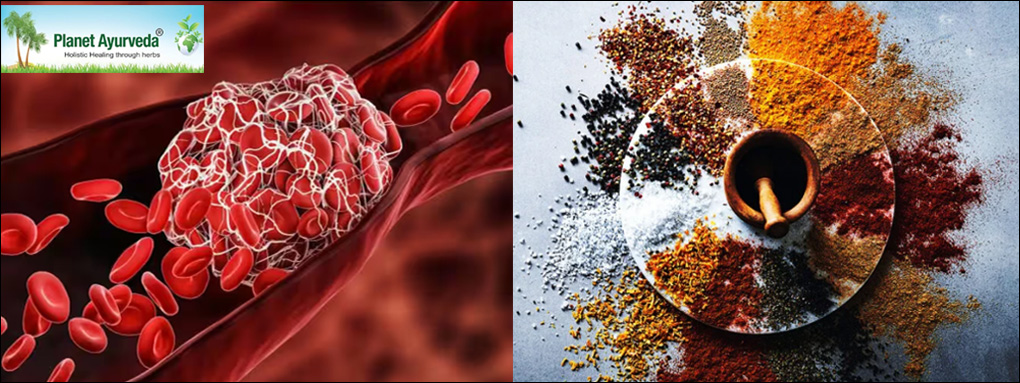How to Choose Ayurvedic Blood Thinner Medicines?
Abstract
Blood thinners are also called anticoagulants, these are the compounds or chemicals that help in the prevention of blood from clotting, clotting can occur in different types of diseases like ischemic heart diseases, atherosclerosis, hypertension, deep vein thrombosis, hyperlipidemia, pulmonary embolism, coronary heart diseases, etc. Here we will discuss the choice of herb to be used as an anticoagulant, their action, and discussion of the herb. What these herbs contain and how it is processed in the body, will be discussed.

Introduction
Blood thinners or anticoagulants are compounds or chemicals or any herbs that when taken will reduce the blood’s ability to clot or reduce the possibility of clot formation by targeting specific proteins involved in the blood clotting cascade, Anticoagulants, antiplatelets, antithrombotic agents cause blood clotting can be many like in coronary heart diseases, in deep vein thrombosis, in pulmonary embolism, hyperlipidemia, ischemic heart diseases, etc. So, it is used to control the clotting or thickening of blood. In Ayurveda, there is a different approach to herbs that act as anticoagulants.
Some Ayurvedic Blood Thinner Herbs
There are different approaches to selecting anticoagulants, antiplatelets, and antithrombotic agents for different diseases. Here are some herbs which act as anticoagulants.
1. Allium sativum (लशुन/रसोन)
Garlic is a very good blood thinner due to its anti-platelet characteristics, in ginger there is a content named Ajoene, a derivative of ginger that contains sulfur. About 33 sulfur compounds like S-Allylmercaptocysteine and Vinyldithiin Ajoene, allicin, Salicylates, etc are found in garlic. Garlic potency depends upon the formulation, Garlic has also fibrinolytic action (an action where plasminogen is converted into plasmin, an enzyme that breaks down fibrin, a blood clotting factor in the blood). It has very good results in atherosclerosis, hyperlipidemia, artery-clogging thrombi, hypertension, diabetes, etc.
When To Use
It is advised for high blood pressure, it improves circulation and reduces strain on the heart, in atherosclerosis (the reduction of the inner layer of the arteries by plaque collection) by reducing cholesterol and preventing clot formation, garlic helps in preventing plaque collection in the arteries, it inhibits platelet aggregation, that means prevent platelets to stick together and form clots, also helpful in conditions like deep vein thrombosis (DVT), Pulmonary embolism (PE), stroke prevention.
2. Zingiber officinale (आर्द्रक)
Ginger has shown plenty of health benefits, like in throat infections, aiding digestion, relieving nausea, reducing inflammation, menstrual camp, arthritis, reducing aggregation of platelets, blood thinning effects, etc. It contains Gingerols, Shogaols which help inhibit the formation of blood clots.
When To Use
It can be selected when there are mild blood circulation issues because it improves circulation, prevents blood clotting, inhibits platelet aggregation, it can be used in people who are at risk of blood clots. It prevents stroke or heart diseases and post-surgical recovery.
3. Curcuma longa (हरिद्रा)
Curcuma longa of Haridra exhibits anticoagulation properties through its active compound known as curcumin, which inhibits platelet aggregation induced by various factors like arachidonic acid, adrenaline, and collagen, thus reducing, the formation of blood clots. It alters the metabolism of eicosanoids (a group of biologically active lipids derived from 20-carbon polyunsaturated fatty acids, most notably arachidonic acid, and includes prostaglandins, thromboxanes, leukotrienes, and lipoxins, acting as local hormones), which are involved in inflammation and blood clotting. It inhibits the formation of thromboxane B2 (TXB2), a potent vasoconstrictor and platelet activator while increasing the formation of 12-lipoxygenase products. Curcumin interferes with spleen tyrosine kinase and phospholipase C gamma, which are involved in platelet activation, further reducing the risk of clot formation, it also prolongs the Prothrombin time (PT) and partial thromboplastin time (APTT) blood clotting factor.
When To Use
It has blood thinning effects, which can prevent cardiac diseases like, Atherosclerosis, high levels of triglycerides, low-density lipoproteins, and very low-density lipoproteins, it also prevents blood from thrombosis as it inhibits the activity of platelets, and slow down blood clotting factor also, in deep vein thrombosis, pulmonary effusion, in the prevention of stroke, post surgical measures, etc.
4. Cayenne pepper (कतुवीर/रक्तमरिच)
It is commonly called red chilly, it also has anticoagulant properties because of the one content in it which is capsaicin, a compound known for its antiplatelet and anticoagulant activity, which helps prevent blood clots and improve blood flow, also it suppresses platelet aggregation that means to prevent platelets from sticking together and forming clots, It also contains salicylates, which have been linked to blood-thinning effects.
When To Use
Cayenne pepper contains capsaicin which has anticoagulation effects, so it can be used in hypertension, atherosclerosis, and thrombosis like Deep vein thrombosis, Pulmonary embolism, has a small role in varicose vein also, peripheral arterial diseases.
5. Syzygium aromaticum (लवंग)
Clove is a herbal drug that is used in many disorders but as an anticoagulant also it works on the body. It has two contents: Eugenol and eugenyl acetate. Clove oil inhibits human platelet aggregation induced by arachidonic acid, platelet-activating factor (PAF), or collagen.
When To Use
Used as an anticoagulant and thrombolytic agent in conditions like atherosclerosis, DVT, pulmonary embolism, etc.
6. Trifolium pratense (त्रिपत्रा)
Commonly known as red clove has blood thinning properties, potentially slowing down clotting, red clover contains coumarin derivatives, which can enhance the effects of anticoagulants and antiplatelet agents. Red clover has mild thrombolytic properties and is used to help break down fibrin in blood clots. It also has a protective effect on blood vessels and supports cardiovascular health.
When To Use
It has blood thinning effects, anticoagulant properties, presence of isoflavones (genistein, daidzein) which are plant-derived phytoestrogens. It can be used in conditions like cardiovascular disease, Atherosclerosis, hypertension, stroke prevention, and menopausal disorders.
7. Fumaria Indica / Fumaria officinalis (पर्पटकः/पर्पट)
It is a plant used in traditional medicine, contains various phytochemicals, including isoquinoline alkaloids, with protopine being a commonly discovered compound. Methanolic extracts of Fumaria officinalis have shown promising anticoagulant and antioxidant activities. These extracts have been found to prolong the prothrombin time (PT) and activated partial thromboplastin time (aPTT), indicators of anticoagulant activity.
When To Use
It can be used in atherosclerosis, and varicose veins, as its having mild diuretic and anti-inflammatory properties also supports haven health, and reduces the risk of clot formation, and autoimmune or inflammatory conditions (like Lupus or rheumatoid arthritis)
8. Ocimum sanctum (Tulsi)
Tulsi is also called holy basil, has shown anticoagulant properties, potentially slowing down blood clotting, and may increase the risk of bruising and bleeding, especially when combined with other medications that also slow blood clotting. Tulsi, particularly its fixed oil, has demonstrated the ability to prolong blood clotting time, similar to the effects of aspirin. The anticoagulant effects are believed to be linked to the presence of compounds like linoleic acid and linolenic acid, which are known for their anti-inflammatory and other beneficial properties.
When To Use
In cardiovascular diseases (in blood clotting and thrombosis), it contains eugenol and rosmarinic acid which helps in blood thinning and can be used in DVT, Pulmonary embolism, arterial thrombosis, atherosclerosis, hypertension, antiphospholipid syndrome, diabetes, stroke prevention.
9. Nelumbo nucifera Gaert (Lotus)
Particularly its leaves, has been traditionally used and studied for its potential hemostatic (blood-clotting) and anticoagulant properties, with some studies suggesting its active compounds can influence blood clotting and platelet aggregation. The hydroalcoholic extract exhibits antithrombotic activity, meaning they can help prevent blood clots. Flavonoids like quercetin and phenolic acids like ferulic acid have anticoagulant effects. The hydroalcoholic extract of lotus plant has shown activity in thrombolytic assays, meaning it can help dissolve blood clots. The extract has also demonstrated anti-platelet aggregation activity, which means it can help prevent blood clots from forming by reducing platelet activity.
When To Use
Used in hypertension as contains flavonoids and alkaloids, nuciferine which relaxes blood vessels and improves blood flow, this will reduce the formation of blood clots, Atherosclerosis, DVT, PE, post-surgical clot prevention, stroke prevention, when deficiency of protein C and S, factor 5 Leiden mutation, antithrombotic lll deficiency.
10. Apium graveolens (अजमोदा)
Celery extract, particularly from the leaves, has demonstrated strong antiplatelet activity, meaning it can inhibit the formation of blood clots. This activity is attributed to compounds like apigenin, which can inhibit adenosine diphosphate (ADP), collagen, and arachidonic acid-induced platelet aggregation. Some studies suggest celery root might slow blood clotting, potentially increasing the risk of bruising and bleeding when taken with medications that also slow blood clotting.
When To Use
It is used in hypertension as it contains phthalides which help blood vessels and improve flow, potentially reducing the risk of thrombotic events, also reducing blood viscosity, help in managing hypertension, Atherosclerosis, DVT, PE, stroke prevention, Hypercoagulable states like in deficiency of protein C and S, factor 5 Leiden mutation, antithrombotic lll deficiency.
11. Nigella sativa Linn (Black cumin or black seed/ उपकुञ्चिका)
Nigella sativa can inhibit clot formation and enhance fibrinolysis, suggesting potential anticoagulant effects, it can also prolong prothrombin time (PT), a measure of blood clotting time, the anticoagulant activity is attributed to the ability of Nigella sativa to inhibit the activity of coagulation factors like factor VII, X, V, prothrombin (II), and fibrinogen in the extrinsic coagulation pathway and thymoquinone, a major constituent of Nigella sativa, has been linked to these anticoagulant properties.
When To Use
A bioactive compound present in its seed that is thymoquinone and also other compounds like nigellone, exerts the inhibition of platelet aggregation, fibrinolytic effects, in hypertension, Atherosclerosis, deep vein thrombosis, pulmonary embolism, and stroke prevention.
12. Psoralea corylifolia Linn ( Babchi or Bakuchi)
It is variously used for various ailments, including skin disorders, cardiovascular problems, and more, the anticoagulant activity is linked to the presence of coumarins, a class of compounds found in the plant, particularly psoralen and is psoralen, other bioactive compounds like flavonoids and meroterpenes, which contribute to its various pharmacological effects, it is also a good choice for the development of new treatments for conditions involving blood clottings, such as deep vein thrombosis and pulmonary embolism.
When To Use
It inhibits Platelet aggregation, modulates coagulation factors, and antithrombotic effects due to the presence of active compound psoralen, Bauhinone, isoflavones, coumarins like umbelliferone, and flavonoids like Quercetin, these all will act as anticoagulants.
Selection Of The Blood Thinner Herbs
- Inhibition of platelet aggregation – Drugs that are explained above like Ginger, garlic, turmeric, cayenne, etc can be used as inhibitors of platelet aggregation.
- As thrombolytic agents – Garlic, ginger, turmeric, clove, red clove, fumaria indica, tulsi.
- Anticoagulants – Garlic, ginger, clove, turmeric, red clove, and black cumin are some good anticoagulants.
Prevention Of Taking Blood Thinners
If a person is on any blood thinners, anticoagulants, or thrombolytic agents like warfarin, heparin, direct oral anticoagulants, like rivaroxaban, and aspirin, clopidogrel, ticagrelor, Alteplase (tPA), reteplase or streptokinase, he/she should avoid taking any herbal anticoagulants or should take advice from health advisor for the intake of these anticoagulants and herbal anticoagulants because it can lead to bleeding disorder from any orifice, because of the low ability of blood to clot.
Conclusion
Ayurvedic blood thinner medicines offer a natural, holistic approach to promoting healthy circulation and preventing blood clotting. Using herbs such as turmeric, ginger, garlic, and Triphala, Ayurvedic remedies can help improve cardiovascular health, detoxify the blood, and support overall well-being. However, it is crucial to consult with an experienced Ayurvedic practitioner before starting any new herbal treatment, especially if you have existing health conditions or are on prescription medication. By making informed choices and using these remedies responsibly, you can benefit from the natural healing properties of Ayurveda to support a healthy and balanced circulatory system.



